warning SKODA OCTAVIA 2010 2.G / (1Z) Owner's Manual
[x] Cancel search | Manufacturer: SKODA, Model Year: 2010, Model line: OCTAVIA, Model: SKODA OCTAVIA 2010 2.G / (1Z)Pages: 275, PDF Size: 16.43 MB
Page 216 of 275

Breakdown assistance215
Using the system
Safety
Driving Tips
General Maintenance
Breakdown assistance
Technical Data
Breakdown assistanceBreakdown assistanceFirst-aid box* and Warning triangle* (Octavia)The first-aid box* is attached by a strap to the right-hand side of the luggage compart-
ment.
The warning triangle can be attached to th e trim panel of the rear wall with rubber
straps fig. 172 .
If you wish to equip your ve hicle additionally with a warning triangle, please contact a
specialist garage.
Note
Pay attention to the use-by-date of the contents of the first-aid box.
First-aid box* and warning triangle* (Estate car)For vehicles of the type estate car the firs t-aid box and the warning triangle are housed
in a compartment on the right side in th e luggage compartment. You can open the
compartment by turning the locks in the direction of arrow fig. 173 .
If you wish to equip your ve hicle additionally with a warning triangle, please contact a
specialist garage.
Note
Pay attention to the use-by-date of the contents of the first-aid box.Fire extinguisher*The fire extinguisher is attached with st raps in a holder under the driver seat.
Please read carefully the instructions whic h are attached to the fire extinguisher.
The fire extinguisher must be checked by an authorised person or company annually
(please observe the differing legal requirements).
Fig. 172 Placing of the warning triangle
(Octavia)
Fig. 173 Placing of the warning
triangle (Estate car)
s43s.1.book Page 215 Thursday, May 13, 2010 1:21 PM
Page 217 of 275

Breakdown assistance
216WARNING
If the fire extinguisher is not correctl y attached, in case of sudden manoeuvres
or an accident it can be “thrown” through the interior compartment and cause
injuries.
Note
The fire extinguisher must comply with the relevant and valid legal requirements.
Pay attention to the expiration date of the fire extinguisher. If the fire extinguisher
is used after the expiration date, its proper function is no longer assured.
The fire extinguisher is only supplied in certain countries within the scope of
delivery.
Vehicle tool kitThe vehicle tool kit and the lifting jack* are housed in a box in the spare wheel*
fig. 174 or in the space for the spare wheel. There is also space here for the remov-
able ball for the trailer towing device*. Th e box is attached with a strap on the spare
wheel.
The vehicle tool kit contains the following parts (depending on equipment fitted):
Wire clamps for removing the full wheel trims,
Plastic clip for a wheel bolt cover,
Wheel wrench*,
To w i n g e y e ,
Adapter for the wheel bolts lock.*
Screwdriver* for removing the fog lights
18).
Before placing the lifting jack* back in its storage area, screw in the arm of the lifting
jack fully.
WARNING
The factory-supplied lifting jack* is only intended for your model of vehicle.
On no account attempt to lift a heavier vehicle or other loads - risk of injury!
Ensure that the vehicle tool kit is sa fely attached in the luggage compart-
ment.Note
Ensure that the box is always secured with the strap.Tyre repair kit*The tyre repair kit is intended for the repair of minor tyre defects. The tyre repair kit
contains a compressor, inflation bottle, operating instructions and accessories.
The repair with the tyre repair kit is not at all intended to replace a permanent repair
on the tyre, this repair only serves to reach the next specialist garage. The repair can be
undertaken on the vehicle immediately. Please read the attached instructions care-
fully before the repair.
The tyre repair kit is located in a textile bag. There is a velcro fastener on the underside
of the bag, with which the bag is attached to the floor covering of the luggage compart-
ment in such a way that the side of the bag rests on the right side of the luggage
compartment and on the seat backrest.
Fig. 174 Luggage compartment: storage
compartment for vehicle tool kit
18)Valid for Octavia RS and Octavia Scout.
s43s.1.book Page 216 Thursday, May 13, 2010 1:21 PM
Page 218 of 275

Breakdown assistance217
Using the system
Safety
Driving Tips
General Maintenance
Breakdown assistance
Technical Data
Spare wheel*The spare wheel lies in a well under the floor covering of the luggage compartment and
is fixed in place using special screws fig. 175 .
Before removing the spare wheel, you must take out the box with the vehicle tool kit
box page 216, fig. 174.
One should check the inflation pressure in the spare wheel (at best when generally
checking the tyre air pressures - see sign on the fuel filler flap page 208) to ensure
that the spare wheel is always ready to use.
Temporary spare wheel
A warning label displayed on the rim of the temporary spare wheel indicates that your
vehicle is equippe d with a temporary spare wheel.
Please observe the following notes when driving with a temporary spare wheel:
The warning label must not be covered after installing the wheel.
Do not drive faster than 80 km/h with this spare wheel and pay particular attention
while driving. Avoid accelerating at full throttle, sharp braking and fast cornering.
The inflation pressure for this spare wheel is identical to the inflation pressure of
the standard tyres. The temporary spare wheel R 18 must have an inflation pressure of
420 kPa (4.2 bar)!
Use this spare wheel only to reach the nearest specialist garage as it is not intended
for continuous use.
No other summer or winter tyres must be mounted on the rim of the spare wheel
R 18.
Changing a wheelPreliminary workThe following steps should be carried ou t before actually changing the wheel.
– If it is necessary to change a wheel, park the vehicle as far away as possible from
the traffic flow. The place you choose should be level.
–Have all the occupants get out. While changing a wheel, the occupants of the
vehicle should not stand on the ro ad (e.g. behind a crash barrier).
– Apply the handbrake firmly.
–Engage 1st gear or if your vehicle is fitted with an automatic gearbox, position the
selector lever into position P .
– If a trailer is coupled, uncouple it.
–Take the vehicle tool kit page 216 and the spare wheel* page 217 out of the
luggage compartment.
WARNING
If you find yourself in flowing traffic switch on the hazard warning lights
system and place the warning triangle on the side of the road at the prescribed
distance from your vehicle while observin g all national legal provisions. In this
way you are protecting not only yourself but also other road users.
Never start the engine with the vehicle si tting on the raised jack - danger of
suffering injury.Caution
If you have to change a wheel on a slope fi rst block the opposite wheel with a stone or
similar object in order to secure the vehicle from unexpectedly rolling away.
Note
Comply with the national legal regulations.
Fig. 175 Luggage compartment: Spare
wheel
s43s.1.book Page 217 Thursday, May 13, 2010 1:21 PM
Page 219 of 275
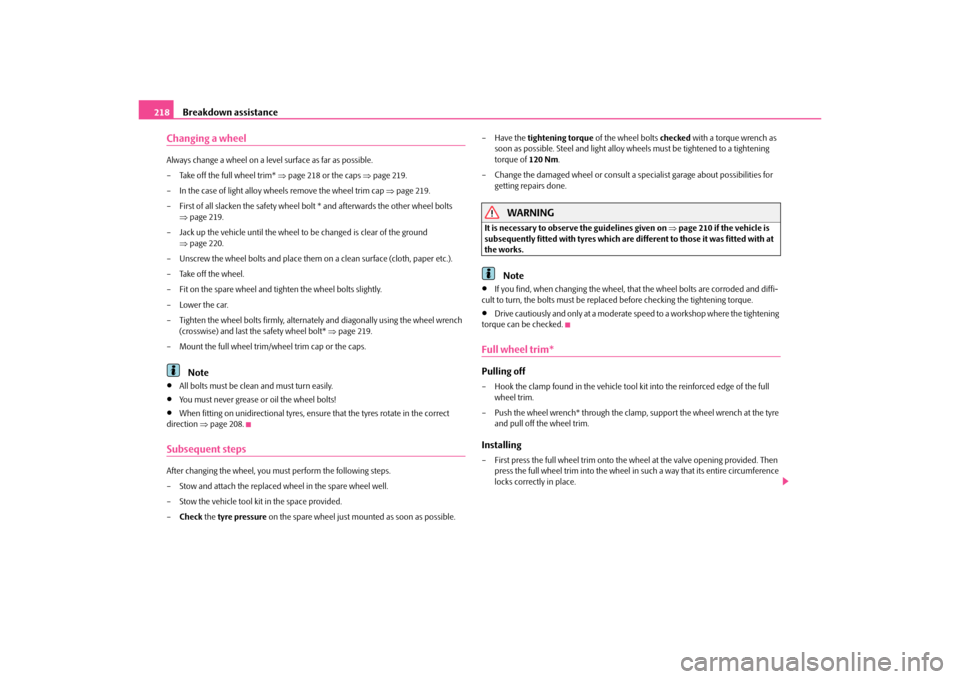
Breakdown assistance
218
Changing a wheelAlways change a wheel on a level surface as far as possible.
– Take off the full wheel trim* page 218 or the caps page 219.
– In the case of light alloy wheels remove the wheel trim cap page 219.
– First of all slacken the safety wheel bolt * and afterwards the other wheel bolts page 219.
– Jack up the vehicle until the wheel to be changed is clear of the ground page 220.
– Unscrew the wheel bolts and place them on a clean surface (cloth, paper etc.).
– Take off the wheel.
– Fit on the spare wheel and ti ghten the wheel bolts slightly.
–Lower the car.
– Tighten the wheel bolts firmly, alternately and diagonally using the wheel wrench (crosswise) and last the safety wheel bolt* page 219.
– Mount the full wheel trim/wheel trim cap or the caps.
Note
All bolts must be clean and must turn easily.
You must never grease or oil the wheel bolts!
When fitting on unidirectional tyres, ensu re that the tyres rotate in the correct
direction page 208.
Subsequent stepsAfter changing the wheel, you must perform the following steps.
– Stow and attach the replaced wheel in the spare wheel well.
– Stow the vehicle tool kit in the space provided.
– Check the tyre pressure on the spare wheel just mounted as soon as possible. – Have the
tightening torque of the wheel bolts checked with a torque wrench as
soon as possible. Steel and light alloy wheels must be tightened to a tightening
torque of 120 Nm.
– Change the damaged wheel or consult a sp ecialist garage about possibilities for
getting repairs done.
WARNING
It is necessary to observe the guidelines given on page 210 if the vehicle is
subsequently fitted with tyres which are di fferent to those it was fitted with at
the works.
Note
If you find, when changing the wheel, that the wheel bolts are corroded and diffi-
cult to turn, the bolts must be replaced before checking the tightening torque.
Drive cautiously and only at a moderate speed to a workshop where the tightening
torque can be checked.
Full wheel trim*Pulling off– Hook the clamp found in the vehicle tool ki t into the reinforced edge of the full
wheel trim.
– Push the wheel wrench* through the clamp, support the wheel wrench at the tyre and pull off the wheel trim.Installing– First press the full wheel trim onto the wheel at the valve opening provided. Then
press the full wheel trim into the wheel in such a way that its entire circumference
locks correctly in place.
s43s.1.book Page 218 Thursday, May 13, 2010 1:21 PM
Page 221 of 275
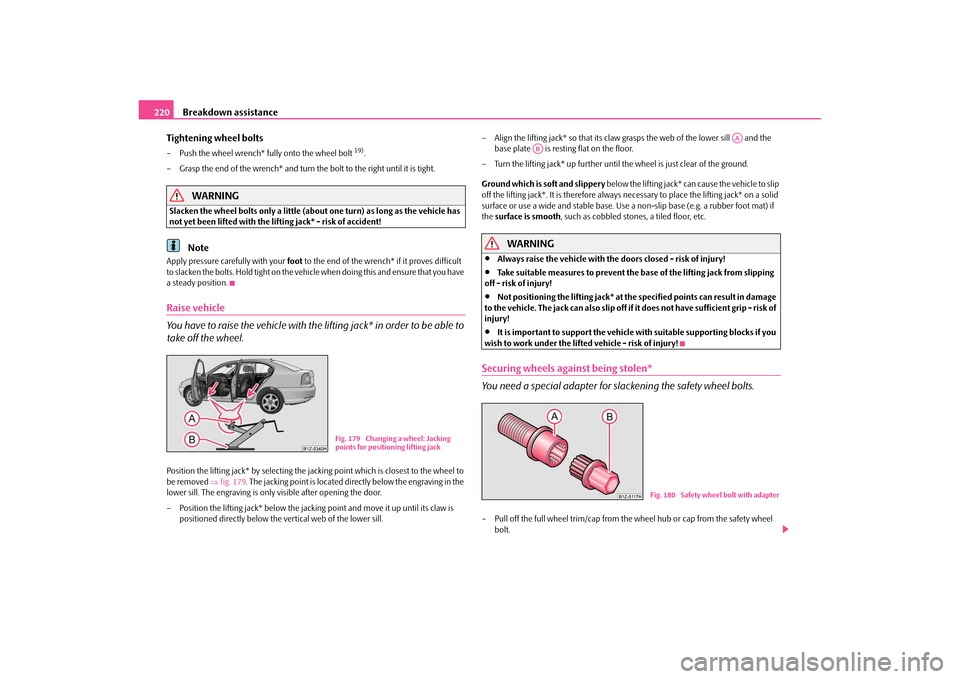
Breakdown assistance
220
Tightening wheel bolts
– Push the wheel wrench* fully onto the wheel bolt
19).
– Grasp the end of the wrench* and turn the bolt to the right until it is tight.
WARNING
Slacken the wheel bolts only a little (about one turn) as long as the vehicle has
not yet been lifted with the lifting jack* - risk of accident!
Note
Apply pressure carefully with your foot to the end of the wrench* if it proves difficult
to slacken the bolts. Hold tight on the vehicl e when doing this and ensure that you have
a steady position.Raise vehicle
You have to raise the vehicle with the lifting jack* in order to be able to
take off the wheel.Position the lifting jack* by selecting the ja cking point which is closest to the wheel to
be removed fig. 179 . The jacking point is located directly below the engraving in the
lower sill. The engraving is only visible after opening the door.
– Position the lifting jack* below the jacking point and move it up until its claw is
positioned directly below the vertical web of the lower sill. – Align the lifting jack* so that its claw
grasps the web of the lower sill and the
base plate is resting flat on the floor.
– Turn the lifting jack* up further until the wheel is just clear of the ground.
Ground which is soft and slippery below the lifting jack* can cause the vehicle to slip
off the lifting jack*. It is therefore always necessary to place the lifting jack* on a solid
surface or use a wide and stable base. Use a non-slip base (e.g. a rubber foot mat) if
the surface is smooth, such as cobbled stones, a tiled floor, etc.
WARNING
Always raise the vehicle with the doors closed - risk of injury!
Take suitable measures to prevent the ba se of the lifting jack from slipping
off - risk of injury!
Not positioning the lifting jack* at the specified points can result in damage
to the vehicle. The jack can al so slip off if it does not have sufficient grip - risk of
injury!
It is important to support the vehicle with suitable supporting blocks if you
wish to work under the lifted vehicle - risk of injury!
Securing wheels against being stolen*
You need a special adapter for sl ackening the safety wheel bolts.– Pull off the full wheel trim/cap from the wheel hub or cap from the safety wheel
bolt.
Fig. 179 Changing a wheel: Jacking
points for positioning lifting jack
AA
AB
Fig. 180 Safety wheel bolt with adapter
s43s.1.book Page 220 Thursday, May 13, 2010 1:21 PM
Page 222 of 275
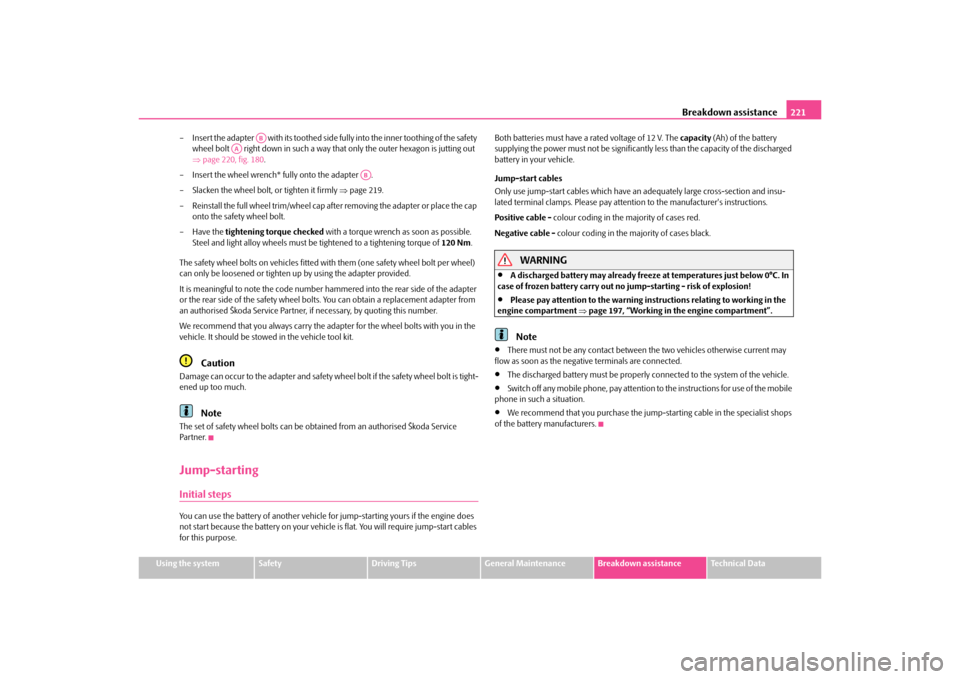
Breakdown assistance221
Using the system
Safety
Driving Tips
General Maintenance
Breakdown assistance
Technical Data
– Insert the adapter with its toothed side fu
lly into the inner toothing of the safety
wheel bolt right down in such a way that only the outer hexagon is jutting out
page 220, fig. 180 .
– Insert the wheel wrench* fully onto the adapter .
– Slacken the wheel bolt, or tighten it firmly page 219.
– Reinstall the full wheel trim/wheel cap afte r removing the adapter or place the cap
onto the safety wheel bolt.
– Have the tightening torque checked with a torque wrench as soon as possible.
Steel and light alloy wheels must be tightened to a tightening torque of 120 Nm .
The safety wheel bolts on vehicles fitted wi th them (one safety wheel bolt per wheel)
can only be loosened or tighten up by using the adapter provided.
It is meaningful to note the code number hammered into the rear side of the adapter
or the rear side of the safety wheel bolts. You can obtain a replacement adapter from
an authorised Škoda Service Partner, if necessary, by quoting this number.
We recommend that you always carry the adapter for the wheel bolts with you in the
vehicle. It should be stow ed in the vehicle tool kit.
Caution
Damage can occur to the adapter and safety wh eel bolt if the safety wheel bolt is tight-
ened up too much.
Note
The set of safety wheel bolts can be obtained from an authorised Škoda Service
Par tner.Jump-startingInitial stepsYou can use the battery of another vehicle for jump-starting yours if the engine does
not start because the battery on your vehicle is flat. You will require jump-start cables
for this purpose. Both batteries must have a rated voltage of 12 V. The
capacity (Ah) of the battery
supplying the power must not be significantly less than the capacity of the discharged
battery in your vehicle.
Jump-start cables
Only use jump-start cables which have an adequately large cross-section and insu-
lated terminal clamps. Please pay attention to the manufacturer's instructions.
Positive cable - colour coding in the majority of cases red.
Negative cable - colour coding in the majority of cases black.
WARNING
A discharged battery may already freeze at temperatures just below 0°C. In
case of frozen battery carry out no jump-starting - risk of explosion!
Please pay attention to the warning instructions relating to working in the
engine compartment page 197, “Working in the engine compartment”.Note
There must not be any contact between the two vehicles otherwise current may
flow as soon as the negati ve terminals are connected.
The discharged battery must be properly connected to the system of the vehicle.
Switch off any mobile phone, pay attention to the instructions for use of the mobile
phone in such a situation.
We recommend that you purchase the jump -starting cable in the specialist shops
of the battery manufacturers.
AB
AA
AB
s43s.1.book Page 221 Thursday, May 13, 2010 1:21 PM
Page 223 of 275
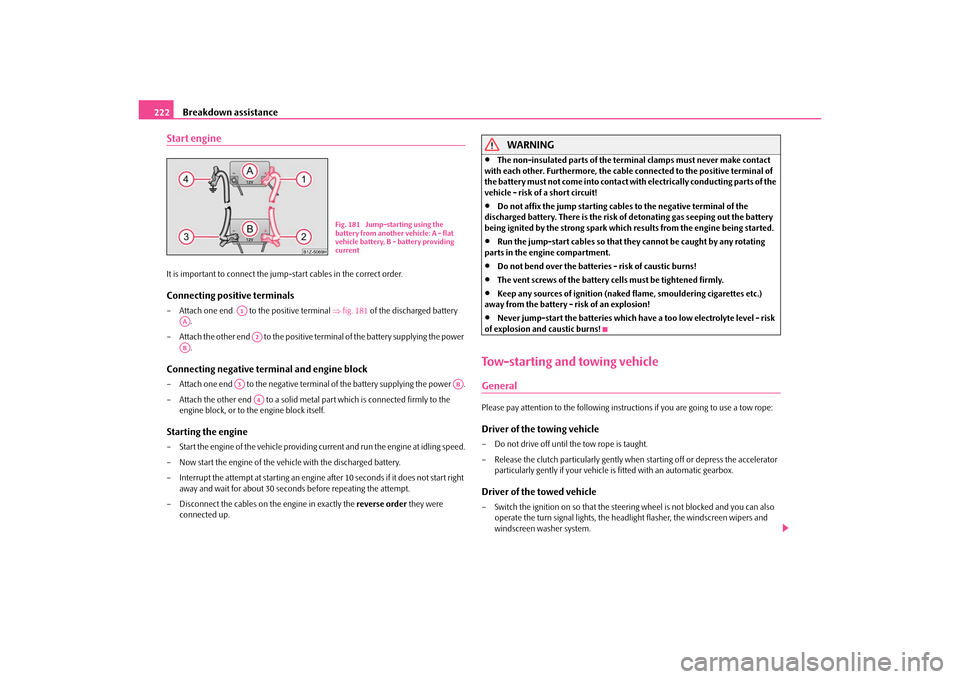
Breakdown assistance
222
Start engineIt is important to connect the jump -start cables in the correct order.Connecting positive terminals– Attach one end to the positive terminal fig. 181 of the discharged battery
.
– Attach the other end to the positive term inal of the battery supplying the power
.Connecting negative terminal and engine block– Attach one end to the negative termin al of the battery supplying the power .
– Attach the other end to a solid metal part which is connected firmly to the
engine block, or to the engine block itself.Starting the engine– Start the engine of the vehicle providing current and run the engine at idling speed.
– Now start the engine of the vehicle with the discharged battery.
– Interrupt the attempt at starting an engine after 10 seconds if it does not start right
away and wait for about 30 seconds before repeating the attempt.
– Disconnect the cables on the engine in exactly the reverse order they were
connected up.
WARNING
The non-insulated parts of the terminal clamps must never make contact
with each other. Furthermore, the cable connected to the positive terminal of
the battery must not come into contact with electrically conducting parts of the
vehicle - risk of a short circuit!
Do not affix the jump starting cables to the negative terminal of the
discharged battery. There is the risk of detonating gas seeping out the battery
being ignited by the strong spark which results from the engine being started.
Run the jump-start cables so that they cannot be caught by any rotating
parts in the engine compartment.
Do not bend over the batteries - risk of caustic burns!
The vent screws of the battery cells must be tightened firmly.
Keep any sources of ignition (naked flame, smouldering cigarettes etc.)
away from the battery - risk of an explosion!
Never jump-start the batteries which ha ve a too low electrolyte level - risk
of explosion and caustic burns!
Tow-starting and towing vehicleGeneralPlease pay attention to the following instru ctions if you are going to use a tow rope:Driver of the towing vehicle– Do not drive off until the tow rope is taught.
– Release the clutch particularly gently wh en starting off or depress the accelerator
particularly gently if yo ur vehicle is fitted with an automatic gearbox.Driver of the towed vehicle– Switch the ignition on so that the steeri ng wheel is not blocked and you can also
operate the turn signal lights, the headlight flasher, the windscreen wipers and
windscreen washer system.
Fig. 181 Jump-starting using the
battery from another vehicle: A - flat
vehicle battery, B - battery providing
current
A1
AA
A2
AB
A3
AB
A4
s43s.1.book Page 222 Thursday, May 13, 2010 1:21 PM
Page 231 of 275
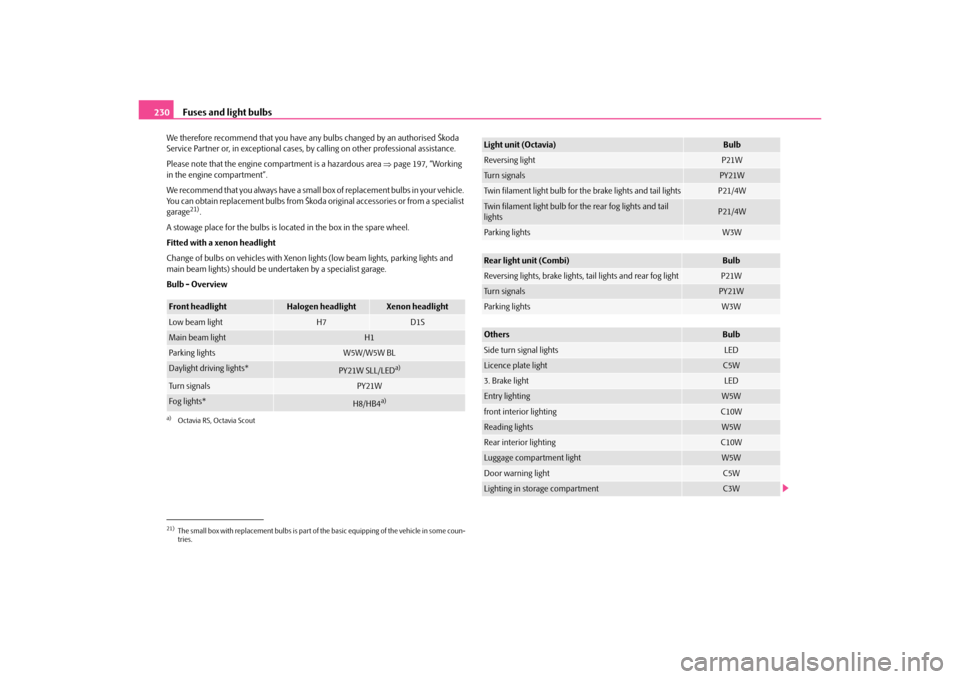
Fuses and light bulbs
230
We therefore recommend that you have an y bulbs changed by an authorised Škoda
Service Partner or, in exceptional cases, by calling on other professional assistance.
Please note that the engine compartment is a hazardous area page 197, “Working
in the engine compartment”.
We recommend that you always have a small box of replacement bulbs in your vehicle.
You can obtain replacement bulbs from Škoda original accessories or from a specialist
garage
21).
A stowage place for the bulbs is located in the box in the spare wheel.
Fitted with a xenon headlight
Change of bulbs on vehicles with Xenon lights (low beam lights, parking lights and
main beam lights) should be und ertaken by a specialist garage.
Bulb - Overview
21)The small box with replacement bulbs is part of the basic equipping of the vehicle in some coun-
tries.Front headlight
Halogen headlight
Xenon headlight
Low beam light
H7
D1S
Main beam light
H1
Parking lights
W5W/W5W BL
Daylight driving lights*
PY21W SLL/LED
a)
a)Octavia RS, Octavia ScoutTu r n s i g n a l s
PY21W
Fog lights*
H8/HB4
a)
Light unit (Octavia)
Bulb
Reversing light
P21W
Turn signals
PY21W
Twin filament light bulb for th e brake lights and tail lights
P21/4W
Twin filament light bulb for the rear fog lights and tail
lights
P21/4W
Parking lights
W3W
Rear light unit (Combi)
Bulb
Reversing lights, brake lights, tail lights and rear fog light
P21W
Turn signals
PY21W
Parking lights
W3W
Others
Bulb
Side turn signal lights
LED
Licence plate light
C5W
3. Brake light
LED
Entry lighting
W5W
front interior lighting
C10W
Reading lights
W5W
Rear interior lighting
C10W
Luggage compartment light
W5W
Door warning light
C5W
Lighting in storage compartment
C3W
s43s.1.book Page 230 Thursday, May 13, 2010 1:21 PM
Page 232 of 275
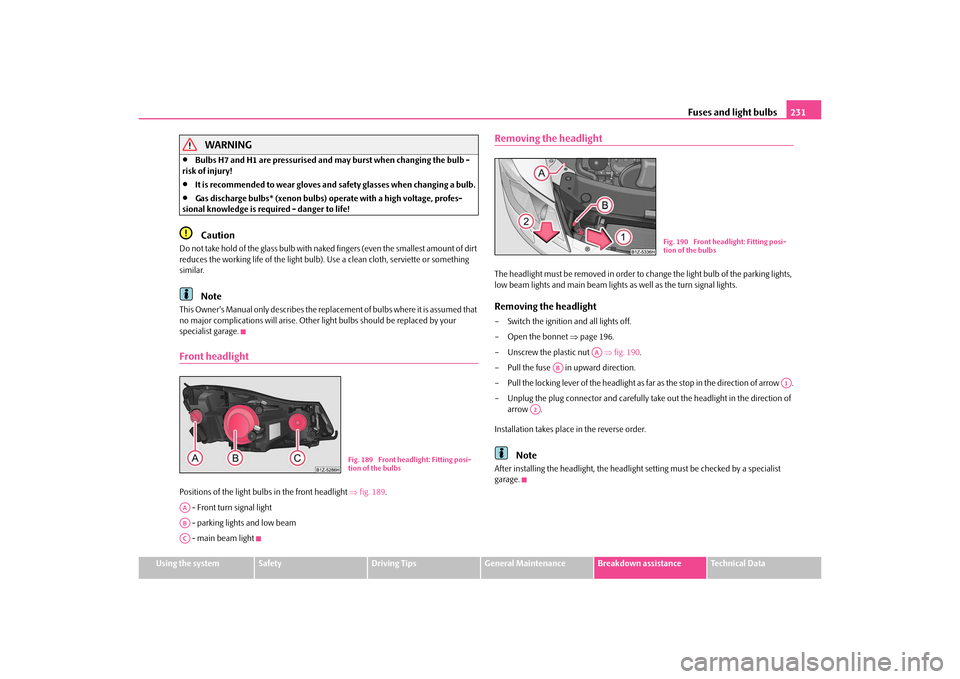
Fuses and light bulbs231
Using the system
Safety
Driving Tips
General Maintenance
Breakdown assistance
Technical Data
WARNING
Bulbs H7 and H1 are pressurised and may burst when changing the bulb -
risk of injury!
It is recommended to wear gloves and safety glasses when changing a bulb.
Gas discharge bulbs* (xenon bulbs) operate with a high voltage, profes-
sional knowledge is required - danger to life!Caution
Do not take hold of the glass bulb with naked fingers (even the smallest amount of dirt
reduces the working life of the light bulb). Use a clean cloth, serviette or something
similar.
Note
This Owner's Manual only describes the replacement of bulbs where it is assumed that
no major complications will arise. Other light bulbs should be replaced by your
specialist garage.Front headlightPositions of the light bulbs in the front headlight fig. 189 .
- Front turn signal light
- parking lights and low beam
- main beam light
Removing the headlightThe headlight must be removed in order to ch ange the light bulb of the parking lights,
low beam lights and main beam lights as well as the turn signal lights.Removing the headlight– Switch the ignition and all lights off.
– Open the bonnet page 196.
– Unscrew the plastic nut fig. 190 .
– Pull the fuse in upward direction.
– Pull the locking lever of the headlight as far as the stop in the direction of arrow .
– Unplug the plug connector and carefully ta ke out the headlight in the direction of
arrow .
Installation takes place in the reverse order.
Note
After installing the headlight, the headligh t setting must be checked by a specialist
garage.
Fig. 189 Front headlight: Fitting posi-
tion of the bulbs
AAABAC
Fig. 190 Front headlight: Fitting posi-
tion of the bulbs
AA
AB
A1
A2
s43s.1.book Page 231 Thursday, May 13, 2010 1:21 PM
Page 264 of 275
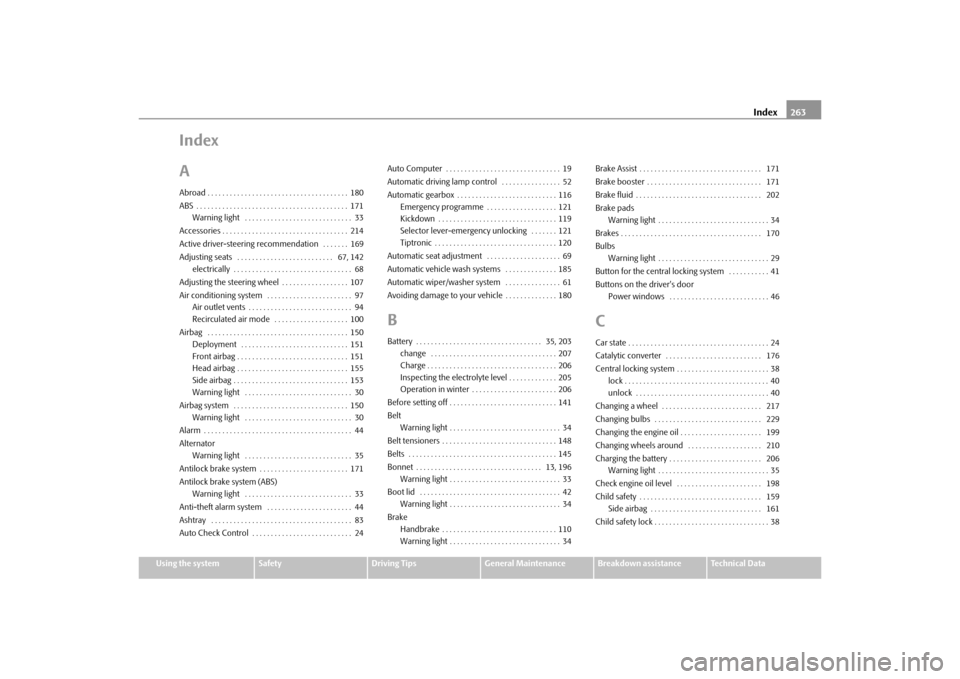
Index263
Using the system
Safety
Driving Tips
General Maintenance
Breakdown assistance
Technical Data
Index
AAbroad . . . . . . . . . . . . . . . . . . . . . . . . . . . . . . . . . . . . . . 180
ABS . . . . . . . . . . . . . . . . . . . . . . . . . . . . . . . . . . . . . . . . . 171
Warning light . . . . . . . . . . . . . . . . . . . . . . . . . . . . . 33
Accessories . . . . . . . . . . . . . . . . . . . . . . . . . . . . . . . . . . 214
Active driver-steering recommendation . . . . . . . 169
Adjusting seats . . . . . . . . . . . . . . . . . . . . . . . . . . 67, 142 electrically . . . . . . . . . . . . . . . . . . . . . . . . . . . . . . . . 68
Adjusting the steering wheel . . . . . . . . . . . . . . . . . . 107
Air conditioning system . . . . . . . . . . . . . . . . . . . . . . . 97 Air outlet vents . . . . . . . . . . . . . . . . . . . . . . . . . . . . 94
Recirculated air mode . . . . . . . . . . . . . . . . . . . . 100
Airbag . . . . . . . . . . . . . . . . . . . . . . . . . . . . . . . . . . . . . . 150 Deployment . . . . . . . . . . . . . . . . . . . . . . . . . . . . . 151
Front airbag . . . . . . . . . . . . . . . . . . . . . . . . . . . . . . 151
Head airbag . . . . . . . . . . . . . . . . . . . . . . . . . . . . . . 155
Side airbag . . . . . . . . . . . . . . . . . . . . . . . . . . . . . . . 153
Warning light . . . . . . . . . . . . . . . . . . . . . . . . . . . . . 30
Airbag system . . . . . . . . . . . . . . . . . . . . . . . . . . . . . . . 150 Warning light . . . . . . . . . . . . . . . . . . . . . . . . . . . . . 30
Alarm . . . . . . . . . . . . . . . . . . . . . . . . . . . . . . . . . . . . . . . . 44
Alternator Warning light . . . . . . . . . . . . . . . . . . . . . . . . . . . . . 35
Antilock brake system . . . . . . . . . . . . . . . . . . . . . . . . 171
Antilock brake system (ABS) Warning light . . . . . . . . . . . . . . . . . . . . . . . . . . . . . 33
Anti-theft alarm system . . . . . . . . . . . . . . . . . . . . . . . 44
Ashtray . . . . . . . . . . . . . . . . . . . . . . . . . . . . . . . . . . . . . . 83
Auto Check Control . . . . . . . . . . . . . . . . . . . . . . . . . . . 24 Auto Computer . . . . . . . . . . . . . . . . . . . . . . . . . . . . . . . 19
Automatic driving lamp control . . . . . . . . . . . . . . . . 52
Automatic gearbox . . . . . . . . . . . . . . . . . . . . . . . . . . . 116
Emergency programme . . . . . . . . . . . . . . . . . . . 121
Kickdown . . . . . . . . . . . . . . . . . . . . . . . . . . . . . . . . 119
Selector lever-emergency unlocking . . . . . . . 121
Tiptronic . . . . . . . . . . . . . . . . . . . . . . . . . . . . . . . . . 120
Automatic seat adjustment . . . . . . . . . . . . . . . . . . . . 69
Automatic vehicle wash systems . . . . . . . . . . . . . . 185
Automatic wiper/washer system . . . . . . . . . . . . . . . 61
Avoiding damage to your vehicle . . . . . . . . . . . . . . 180
BBattery . . . . . . . . . . . . . . . . . . . . . . . . . . . . . . . . . . 35, 203 change . . . . . . . . . . . . . . . . . . . . . . . . . . . . . . . . . . 207
Charge . . . . . . . . . . . . . . . . . . . . . . . . . . . . . . . . . . . 206
Inspecting the electrolyte level . . . . . . . . . . . . . 205
Operation in winter . . . . . . . . . . . . . . . . . . . . . . . 206
Before setting off . . . . . . . . . . . . . . . . . . . . . . . . . . . . . 141
Belt Warning light . . . . . . . . . . . . . . . . . . . . . . . . . . . . . . 34
Belt tensioners . . . . . . . . . . . . . . . . . . . . . . . . . . . . . . . 148
Belts . . . . . . . . . . . . . . . . . . . . . . . . . . . . . . . . . . . . . . . . 145
Bonnet . . . . . . . . . . . . . . . . . . . . . . . . . . . . . . . . . . 13, 196 Warning light . . . . . . . . . . . . . . . . . . . . . . . . . . . . . . 33
Boot lid . . . . . . . . . . . . . . . . . . . . . . . . . . . . . . . . . . . . . . 42 Warning light . . . . . . . . . . . . . . . . . . . . . . . . . . . . . . 34
Brake Handbrake . . . . . . . . . . . . . . . . . . . . . . . . . . . . . . . 110
Warning light . . . . . . . . . . . . . . . . . . . . . . . . . . . . . . 34 Brake Assist . . . . . . . . . . . . . . . . . . . . . . . . . . . . . . . . . 171
Brake booster . . . . . . . . . . . . . . . . . . . . . . . . . . . . . . . 171
Brake fluid . . . . . . . . . . . . . . . . . . . . . . . . . . . . . . . . . . 202
Brake pads
Warning light . . . . . . . . . . . . . . . . . . . . . . . . . . . . . . 34
Brakes . . . . . . . . . . . . . . . . . . . . . . . . . . . . . . . . . . . . . . 170
Bulbs Warning light . . . . . . . . . . . . . . . . . . . . . . . . . . . . . . 29
Button for the central locking system . . . . . . . . . . . 41
Buttons on the driver's door Power windows . . . . . . . . . . . . . . . . . . . . . . . . . . . 46
CCar state . . . . . . . . . . . . . . . . . . . . . . . . . . . . . . . . . . . . . . 24
Catalytic converter . . . . . . . . . . . . . . . . . . . . . . . . . . 176
Central locking system . . . . . . . . . . . . . . . . . . . . . . . . . 38lock . . . . . . . . . . . . . . . . . . . . . . . . . . . . . . . . . . . . . . . 40
unlock . . . . . . . . . . . . . . . . . . . . . . . . . . . . . . . . . . . . 40
Changing a wheel . . . . . . . . . . . . . . . . . . . . . . . . . . . 217
Changing bulbs . . . . . . . . . . . . . . . . . . . . . . . . . . . . . 229
Changing the engine oil . . . . . . . . . . . . . . . . . . . . . . 199
Changing wheels around . . . . . . . . . . . . . . . . . . . . 210
Charging the battery . . . . . . . . . . . . . . . . . . . . . . . . . 206 Warning light . . . . . . . . . . . . . . . . . . . . . . . . . . . . . . 35
Check engine oil level . . . . . . . . . . . . . . . . . . . . . . . 198
Child safety . . . . . . . . . . . . . . . . . . . . . . . . . . . . . . . . . 159 Side airbag . . . . . . . . . . . . . . . . . . . . . . . . . . . . . . 161
Child safety lock . . . . . . . . . . . . . . . . . . . . . . . . . . . . . . . 38
s43s.1.book Page 263 Thursday, May 13, 2010 1:21 PM